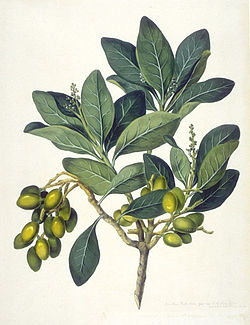| Corynocarpus | |
|---|---|
 | |
| An early illustration of Corynocarpus laevigatus by John Frederick Miller [1] | |
| Scientific classification | |
| Kingdom: | Plantae |
| Clade: | Tracheophytes |
| Clade: | Angiosperms |
| Clade: | Eudicots |
| Clade: | Rosids |
| Order: | Cucurbitales |
| Family: | Corynocarpaceae Engl. [2] |
| Genus: | Corynocarpus J.R.Forst. & G.Forst. |
Corynocarpus is the only genus of plants in the family Corynocarpaceae and includes five species. [3] It is native to New Guinea, Australia, New Zealand, New Caledonia, and Vanuatu. [4]